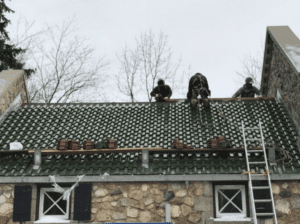
ROXBURY TWP. – There’s building restoration, and then there’s historically accurate building restoration.
And that’s the direction the Lake Hopatcong Foundation took when it came to restoring and replacing the original ceramic tiles on the roof of the old Landing train station.
“We’re so excited to see the quick progress on the installation of the tile roof. The 6,000 historically accurate, glazed clay roofing tiles from Ludowici Roof Tiles were delivered just about a week ago and significant strides on the installation have already been made by Alden Bailey, a firm specializing in tile roofs,” said Lake Hopatcong Foundation spokesperson Holly Odgers.
Odgers posted the update on the Lake Hopatcong Foundation’s official website Wednesday.
“Replacing the roof with the original ceramic tiles was considered an essential step from both a historical and durability standpoint,” she wrote.
The non-profit foundation, with a mission of maintaining and preserving the state’s largest natural water resource, obtained a $215,571 grant from the Morris County Historic Preservation Trust to buy and install the historically accurate tiles.
The project is expected to be completed this week.
Once the former train station is entirely restored and renovated, it will be used for both foundation offices and for the creation of a community center.
“The train station will not be the new home of the Lake Hopatcong Museum,” said Donna Macalle-Holly, the foundation’s grants and programs coordinator.
“However, we do plan to host displays at the station on a variety of topics including historical, environmental, etc,” she said. “The sky is the limit on the different types of display we can have at the Lake Hopatcong Cultural and Environmental Center.”
Temporarily, the offices of the foundation are located on the scenic Nolan’s Point Park Road in Lake Hopatcong.
The office building is shared with the Lake Hopatcong Miniature Golf Club and is located near Alice’s Restaurant.
The roof restoration project was the only one in Roxbury Township awarded historic preservation funding by Morris County in 2016.
Last year, the foundation waged a successful fundraising campaign by selling the tiles for $25 each. For the donation, residents and lake enthusiasts were able to sign the tiles, which are now being installed on the roof.
The train station, which borders Landing Road and the New Jersey Transit rail line, was constructed in 1911 by Lackawanna Railroad to serve visitors who would arrive during Lake Hopatcong’s heyday as a resort community.
Landing resident Robin Kline detailed its history in a presentation to the Roxbury Township Council earlier this month.
It remains one of the first structures people see as they approach the southern end of Lake Hopatcong and is one of a handful of prominent historical structures left from the area’s resort days.
Besides serving as a train station, it’s also served as a real estate office and several different stores, including a hardware store and an antique store, according to Kline.
The tracks and platform are still used by NJ Transit’s Montclair-Boonton and Morristown lines during peak travel times.
The station was purchased for around $430,000 and the foundation’s ultimate goal is to raise more than $250,000 for the mortgage and property restoration.
Station’s History
In presenting a brief history of Landing to the Township Council, Kline focused on the landmark station.
“The rail road arrived and the Port Morris rail yards came in 1870. Landing was then filled with bustling railroad traffic,” she said. “A railroad might not seem like a very romantic thing to reminisce about, but it meant a lot to the area,” she said.
At an elevation of 911 feet above sea level, Kline said the Morris Canal was at its highest elevation in Roxbury, and said that, in total, it spanned 107 miles.
“It was the marvel of its day,” she said.
And then, in 1854, the Morris & Essex Railway extended its service from Newark to Hackettstown, right through Landing. “It passed right by the southern tip of Lake Hopatcong,” she said.
The railway initially supported commerce, but by the early 1900’s, she said, people were using it to flock to the lake. At the turn of the century, the Landing Rail Road station was built.
“In May of 1911, the Lackawanna Rail Road Station, as it was then known, opened in Landing. The cost was $29,000 to build and the railroad spent a total of $75,000 to build the accompanying structures around it,” she said.
“Growing up, some of those structures were still in place, and we explored all of them thoroughly as kids,” she recalled.
As a child, she can recall racing to get up to the pedestrian overpass as big diesel engines roared by.
The train station, she said, served four modes of transportation: train, cars, boats traveling via the canal and a trolley.
From Roxbury Register | February 24, 2017




